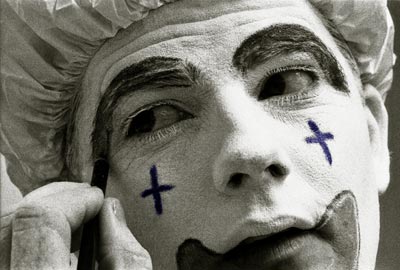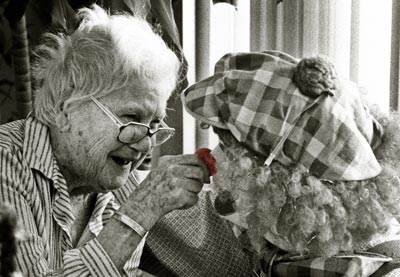
Laughing For The Lord
 He's a different kind of minister.
He's a different kind of minister.
Every weekend, lay minister Gary Carkin dons the vestments of his faith before conducting services for his flock.
First comes the grease paint–lots of it. Then there are the big red suspenders, high top sneakers with bits of fur glued all over them and the curly explosion of an orange wig. Last comes the crowning touch: a round, red, foam nose, applied with lots of glue so his parishioner’s can’t pull it off.
Carkin is definitely a different kind of minister with a different kind of flock.
Dressed as his alter ego, Bernie the Clown, Carkin visits children in pediatric wards and the elderly in convalescent homes. He works to bring a message of laughter and hope to those too ill or infirm to attend a regular church service.
Carkin began his unusual ministry out of desperation in 1987 as he tried to find a way to help his 5-year-old niece. She was severely depressed from three weeks in the hospital after being hit by a car.
“Each time I went down to the hospital she was worse, and I was trying to think of something I could do to cheer her up,” he said. “I prayed and asked, ‘What can I do that’s special?’ and it just hit me—I’ve got that clown outfit.
Carkin had bought the costume three years earlier for Halloween but had never worn it. The first time he visited his niece as a clown she began to recover. Carkin knew he’d found a calling.
“As soon as I walked out the door I said, ‘God, I turn this over to you” he said. “If you want this to go somewhere, lead me.”
Less than a week later, he was organizing a children’s carnival at the First Baptist Church. Today he uses the church as a base for his clown ministry.
Carkin thinks his clown act helps him spread the church’s message more easily.
“A clown is able to cross all barriers,” he explained. “No matter where you go or what you do, you’re accepted. A clown is a universal figure that’s admired by everybody, young or old.”
Almost every weekend, Carkin visits retirement homes, children’s shelters, and hospitals. Even for a clown, it’s not always easy.
“Sometimes I go visit someone and they just start crying because no outsider has come to visit them in years,” he said.
 “It saddens me because we as humans spend a lot of time doing nothing. What would it be if everyone took just a half-hour a week to visit a hospital or a convalescent shelter? They would appreciate what they have.”
“It saddens me because we as humans spend a lot of time doing nothing. What would it be if everyone took just a half-hour a week to visit a hospital or a convalescent shelter? They would appreciate what they have.”
Carkin takes a lot more than half an hour for his visits. He estimates he spends at least 16 hours a week as “Bernie” after working his regular 50-hour shift as a postal carrier.
Even for a 10 minute performance as Bernie, Carkin has to spend two hours getting ready. Preparation starts with facial makeup that incorporates the symbols of Carkin’s ministry. A white base coat of grease paint symbolizes death, according to Carkin. Then he applies symbolic rainbows on his cheeks and small crosses under each eye to signify rebirth.
After putting on his costume, Carkin loads up his car for the day’s work. There are several cases of magic tricks and makeup and two large puppets, which are used in his act. Also needed are a portable tape player and boxes of candy and prizes Carkin hands out whenever he does a children’s show.
Carkin finances his ministry activities with donations of money and materials from local organizations. He also does children’s parties and other public events to raise money, but stresses that he never turns down an engagement just because someone can’t pay.
Carkin also tries to be sensitive to the religious preferences of his audiences, overtly praying or mentioning the church only after getting permission in advance.
Even in secular situation, Carkin tries to leave his audiences with lasting benefits.
“My responsibility to my ministry is to lift people up, not bring anyone down,” he said. “I still mention love and caring and try to teach positive things.”
But no matter what kind of audience he’s playing for, Carkin still loves the mission he and “Bernie” have found.
“I get more than money can buy,” he said. “I wouldn’t trade a smile I get any day for a million dollars. If I didn’t have to pay my bills, I’d quit work and spend 100 percent of my time doing this.”